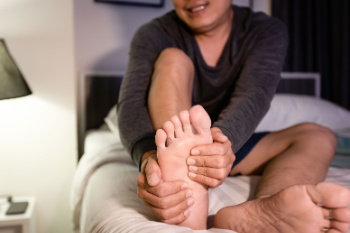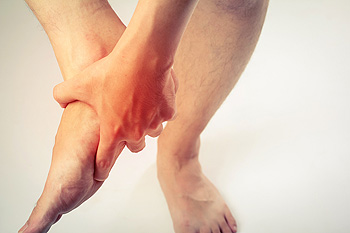Items filtered by date: June 2024
Do Your Child's Feet Hurt?
How to Prevent Sock Blisters

Preventing sock blisters involves considering several key factors. Choosing the right sock material is vital, as synthetic blends or merino wool are excellent options because they wick moisture away from the skin and reduce friction. Cotton socks, on the other hand, tend to retain moisture, increasing the risk of blisters. Ensuring the correct sock size is also essential. Socks that are too tight can cause pressure points, while those that are too loose can create folds that rub against the skin. Additionally, the construction of the sock matters, as seamless socks or those with flat seams minimize irritation. Padded socks can provide extra cushioning and protection in high-friction areas. Paying attention to these details can significantly reduce the likelihood of developing painful sock blisters during activities. If you have developed blisters that have become infected, and would like to know if the socks or shoes are causing them, it is suggested that you consult a podiatrist who can offer correct treatment and prevention strategies.
Blisters may appear as a single bubble or in a cluster. They can cause a lot of pain and may be filled with pus, blood, or watery serum. If your feet are hurting, contact Brandon M. Zuklie, DPM of New Jersey. Our doctor can provide the care you need to keep you pain-free and on your feet.
Foot Blisters
Foot blisters are often the result of friction. This happens due to the constant rubbing from shoes, which can lead to pain.
What Are Foot Blisters?
A foot blister is a small fluid-filled pocket that forms on the upper-most layer of the skin. Blisters are filled with clear fluid and can lead to blood drainage or pus if the area becomes infected.
Symptoms
(Blister symptoms may vary depending on what is causing them)
- Bubble of skin filled with fluid
- Redness
- Moderate to severe pain
- Itching
Prevention & Treatment
In order to prevent blisters, you should be sure to wear comfortable shoes with socks that cushion your feet and absorb sweat. Breaking a blister open may increase your chances of developing an infection. However, if your blister breaks, you should wash the area with soap and water immediately and then apply a bandage to the affected area. If your blisters cause severe pain it is important that you call your podiatrist right away.
If you have any questions, please feel free to contact our offices located in Piscataway, Jamesburg, and Branchburg, NJ . We offer the newest diagnostic and treatment technologies for all your foot care needs.
Symptoms and Causes of Plantar Fasciitis

Plantar fasciitis affects millions of people worldwide and is primarily found in active adults from 25 to 65 years old. Plantar fasciitis arises from the overstretching of the plantar fascia, a fibrous band of tissue on the sole of the foot that supports the arch. The major symptoms of inflammation and pain may develop gradually over time or suddenly after intense physical activity. The hallmark sign of plantar fasciitis is pain near the heel. This can range from a dull ache to a sharp, stabbing sensation, often most severe upon waking in the morning or after prolonged rest. Additional indicators include tenderness to touch, stiffness, and increased discomfort after extended periods of activity. Factors that contribute to its onset include repetitive stress from activities like running, dancing, or prolonged standing. Other possible causes are excess weight, improper footwear, and biomechanical issues, such as high or low foot arches. If you are experiencing persistent heel pain that may be linked to plantar fasciitis, it is suggested that you make an appointment with a podiatrist for an exam and diagnosis, followed by treatment options.
Plantar fasciitis can be very painful and inconvenient. If you are experiencing heel pain or symptoms of plantar fasciitis, contact Brandon M. Zuklie, DPM from New Jersey. Our doctor can provide the care you need to keep you pain-free and on your feet.
What Is Plantar Fasciitis?
Plantar fasciitis is the inflammation of the thick band of tissue that runs along the bottom of your foot, known as the plantar fascia, and causes mild to severe heel pain.
What Causes Plantar Fasciitis?
- Excessive running
- Non-supportive shoes
- Overpronation
- Repeated stretching and tearing of the plantar fascia
How Can It Be Treated?
- Conservative measures – anti-inflammatories, ice packs, stretching exercises, physical therapy, orthotic devices
- Shockwave therapy – sound waves are sent to the affected area to facilitate healing and are usually used for chronic cases of plantar fasciitis
- Surgery – usually only used as a last resort when all else fails. The plantar fascia can be surgically detached from the heel
While very treatable, plantar fasciitis is definitely not something that should be ignored. Especially in severe cases, speaking to your doctor right away is highly recommended to avoid complications and severe heel pain. Your podiatrist can work with you to provide the appropriate treatment options tailored to your condition.
If you have any questions please feel free to contact our offices located in Piscataway, Jamesburg, and Branchburg, NJ . We offer the newest diagnostic and treatment technologies for all your foot and ankle needs.
High Ankle Sprains in Athletes

High ankle sprains, prevalent among athletes, are distinct from traditional ankle sprains due to the affected ligaments. These injuries typically occur during sudden twists or impacts that force the foot upwards, straining the ligaments connecting the two lower leg bones, the tibia, and fibula. These are unlike common ankle sprains, which involve the ligaments on the sides of the ankle. The injury causes pain, swelling, and instability, hindering mobility and performance. Sports that involve rapid changes in direction or jumping, such as basketball, soccer, and football, pose a higher risk. Factors like insufficient warm-up, wearing improper footwear, and fatigue exacerbate the likelihood of injury. Timely diagnosis and appropriate treatment, including rest, compression, and elevation, are critical for recovery and prevent long-term complications in athletes. If you have suffered an ankle sprain during a sporting activity, it is suggested that you consult a podiatrist who can determine which type of sprain it is, and treat it accordingly.
Although ankle sprains are common, they aren’t always minor injuries. If you need your ankle injury looked at, contact Brandon M. Zuklie, DPM from New Jersey. Our doctor can provide the care you need to keep you pain-free and on your feet.
How Does an Ankle Sprain Occur?
Ankle sprains are the result of a tear in the ligaments within the ankle. These injuries may happen when you make a rapid shifting movement while your foot is planted. A less common way to sprain your ankle is when your ankle rolls inward while your foot turns outward.
What Are the Symptoms?
- Pain at the sight of the tear
- Bruising/Swelling
- Ankle area is tender to touch
- In severe cases, may hear/feel something tear
- Skin discoloration
Preventing a Sprain
- Wearing appropriate shoes for the occasion
- Stretching before exercises and sports
- Knowing your limits
Treatment of a Sprain
In many cases, the RICE method (Rest, Ice, Compression, and Elevate) is used to treat ankle sprains. However, you should see a podiatrist to see which treatment option would work best with your injury. In severe cases, surgery may be required.
It is important to ask your doctor about rehab options after you receive treatment for your injury. Stretching, strength training, and balance exercises may help the ankle heal while also preventing further injury.
If you have any questions, please feel free to contact our offices located in Piscataway, Jamesburg, and Branchburg, NJ . We offer the newest diagnostic and treatment technologies for all your foot care needs.
How to Manage Plantar Fasciitis
 Heel pain is a frequent concern, often associated with conditions such as plantar fasciitis. Plantar fasciitis is a painful condition that occurs when the thick band of tissue under your foot, known as the plantar fascia, becomes inflamed. This commonly results from daily activities like running, standing for long periods, or wearing improper shoes. Podiatrists, or foot doctors, can help treat plantar fasciitis and relieve pain in multiple ways. Podiatrists may recommend specific stretching exercises to release tightness in the plantar fascia or they may customize orthotic inserts to support the foot. In some cases, they may suggest anti-inflammatory medications or corticosteroid injections aiming to reduce pain and inflammation. With proper guidance from a podiatrist, heel pain caused by plantar fasciitis can become more controlled. If you are suffering with heel pain or conditions such as plantar fasciitis, it is suggested that you consult a podiatrist to find a treatment best fit for your specific condition.
Heel pain is a frequent concern, often associated with conditions such as plantar fasciitis. Plantar fasciitis is a painful condition that occurs when the thick band of tissue under your foot, known as the plantar fascia, becomes inflamed. This commonly results from daily activities like running, standing for long periods, or wearing improper shoes. Podiatrists, or foot doctors, can help treat plantar fasciitis and relieve pain in multiple ways. Podiatrists may recommend specific stretching exercises to release tightness in the plantar fascia or they may customize orthotic inserts to support the foot. In some cases, they may suggest anti-inflammatory medications or corticosteroid injections aiming to reduce pain and inflammation. With proper guidance from a podiatrist, heel pain caused by plantar fasciitis can become more controlled. If you are suffering with heel pain or conditions such as plantar fasciitis, it is suggested that you consult a podiatrist to find a treatment best fit for your specific condition.
Many people suffer from bouts of heel pain. For more information, contact Brandon M. Zuklie, DPM of New Jersey. Our doctor can provide the care you need to keep you pain-free and on your feet.
Causes of Heel Pain
Heel pain is often associated with plantar fasciitis. The plantar fascia is a band of tissues that extends along the bottom of the foot. A rip or tear in this ligament can cause inflammation of the tissue.
Achilles tendonitis is another cause of heel pain. Inflammation of the Achilles tendon will cause pain from fractures and muscle tearing. Lack of flexibility is also another symptom.
Heel spurs are another cause of pain. When the tissues of the plantar fascia undergo a great deal of stress, it can lead to ligament separation from the heel bone, causing heel spurs.
Why Might Heel Pain Occur?
- Wearing ill-fitting shoes
- Wearing non-supportive shoes
- Weight change
- Excessive running
Treatments
Heel pain should be treated as soon as possible for immediate results. Keeping your feet in a stress-free environment will help. If you suffer from Achilles tendonitis or plantar fasciitis, applying ice will reduce the swelling. Stretching before an exercise like running will help the muscles. Using all these tips will help make heel pain a condition of the past.
If you have any questions please contact our offices located in Piscataway, Jamesburg, and Branchburg, NJ . We offer the newest diagnostic and treatment technologies for all your foot and ankle needs.

